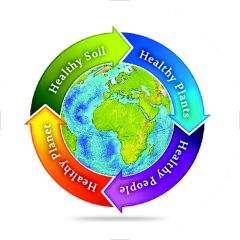Yellow, black, red, orange, white, purple tomatoes…..
And each absolutely delicious.
Two years ago, when we first moved to our current location in Vermont, absolutely nothing would grow in the hard-pack heavy clay soils (except weeds).
Nor was there much any life in those depleted soils.
We immediately began amending those dead soils, with our own vermicast and natural, vegan, botanical-based high-grade amendments.
Now those formerly dead & depleted soils are rich, productive, self-sustaining, and completely regenerative.
We have more tomato, pepper, squash, eggplant, bean, pea, potato, soybean, herb and other plants than we know what to do with.
And we have more produce & herbs than we can possibly consume ourselves.
And not only are the soils now ultra-rich & productive, but now also absolutely teaming with life.
Beneficial microbes that have supported worms & insects (including massive numbers of pollinators, ladybugs, etc.), which have supported massive numbers & varieties of beautiful birds.
THIS IS THE POWER OF NATURE, AND VERMICAST!
P.S. – Our plants came from our own seeds, which came from our own plants last year which were grown in our own vermicast (except for the White Cherry Tomatoes, which came from Nikitovka Seeds in the Ukraine……whom truly deserve a mention here).
Blog
Upon first arriving at my new place, I was surprised to find, despite a lot of plants & flowers on the premises, a near complete lack of any pollinators visiting those flowers.
I immediately began amending the soils with NatureSoil Products’ Vermicasts, organic amendments, and liquid feeds.
Now, just one year later, the premises are swarming with active & happy pollinators, eagerly feeding on the pollens & nectars.
From Butterflies to Bees to Wasps to Humming Birds to a large number of smaller & unknown pollinators, these gardens have become naturally happy places.
I’ve attached videos here of flowers where 4-5 bees are crowded inside the flowers, busily walking over each other trying to gather as much pollen & nectar as possible.
Videos of garden spots where half-a-dozen to dozens of butterflies & bees are eagerly feeding on flowers.
See, in my research & observations, humans aren’t the only species that crave better tasting foods.
From animals to insects, it seems Nature’s creatures seek out the best tasting foods.
Even the oft-regarded “lowly” microbes seek out better tasting foods.
Flavonoids, terpenoids, polyphenols, and other natural compounds are often recognized as contributing to characteristics of “flavor”, “taste”, “smell” and other such sensory perceptions.
Those compounds, often largely grouped as Secondary Metabolites, serve vitally important functions in the workings of Nature.
These natural compounds are often formed during the natural decomposition process of organic matter.
And are therefore one of the main benefits of using natural compost in gardening.
Secondary Metabolites are often called Phytochemicals, as they are typically found in most plants.
Those Secondary Metabolites are important to the biological functionings of microbes.
Those microbes are vitally important to the botanical/biological functioning of plants.
Secondary metabolites serve: (i) as competitive weapons used against other bacteria, fungi, amoebae, plants, insects, and large animals; (ii) as metal transporting agents; (iii) as agents of symbiosis between microbes and plants, nematodes, insects, and higher animals; (iv) as sexual hormones; and (v) as differentiation effectors.
It’s all part of the mutually beneficial and co-dependent nature, of Nature.
Synthetic fertilizers DO NOT produce nor provide these Phytochemicals.
So, plants grown in synthetic fertilizers will lack the taste, flavor & smell qualities sought out by humans, animals, insects, microbes & such.
There are a good number of theories as to the cause of the large-scale declines in the numbers of pollinators, and though there are likely a number of different contributing factors, my research & observations have led me to believe that negligence of the importance of these secondary metabolites, in regards to soil & plant care, have resulted in poorer quality plants, which now largely lack the taste & smell characteristics sought by Natures creatures.
And that the majority of plants & flowers, being fed by lower-quality & nutrient deficient synthetic fertilizers, lack the natural nutritional & more complex protective qualities that Natures’ creatures need, to thrive & survive.
Without adequate levels of these Secondary Metabolites, microbes lack the defense to maintain natural health, and ward off pathogens.
Without adequate levels of these Secondary Metabolites, pollinating insects lack the defenses to maintain natural health, and ward off pathogens & disease.
Enjoy these following videos (clicking on the images will take you to an external YouTube site):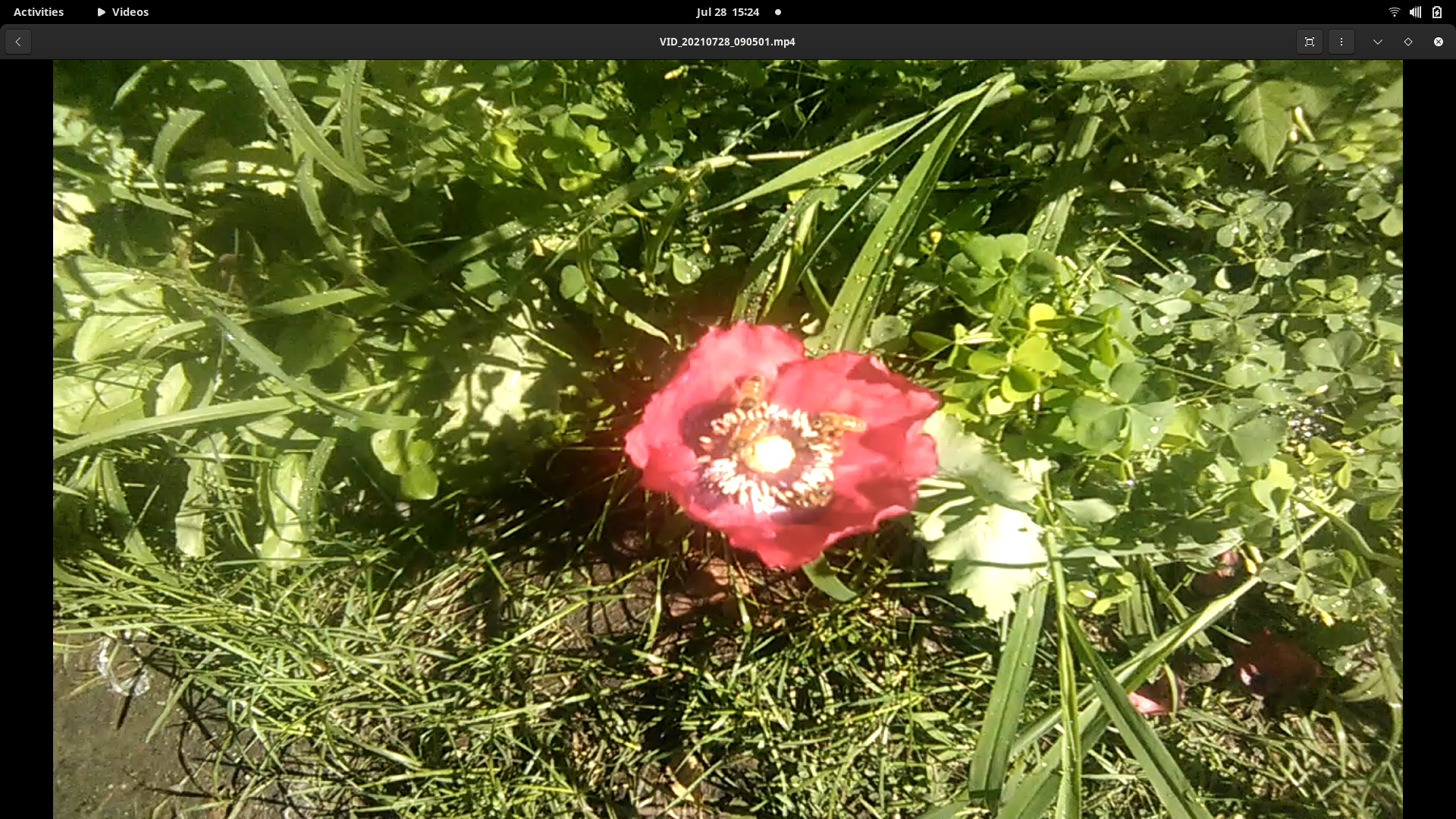
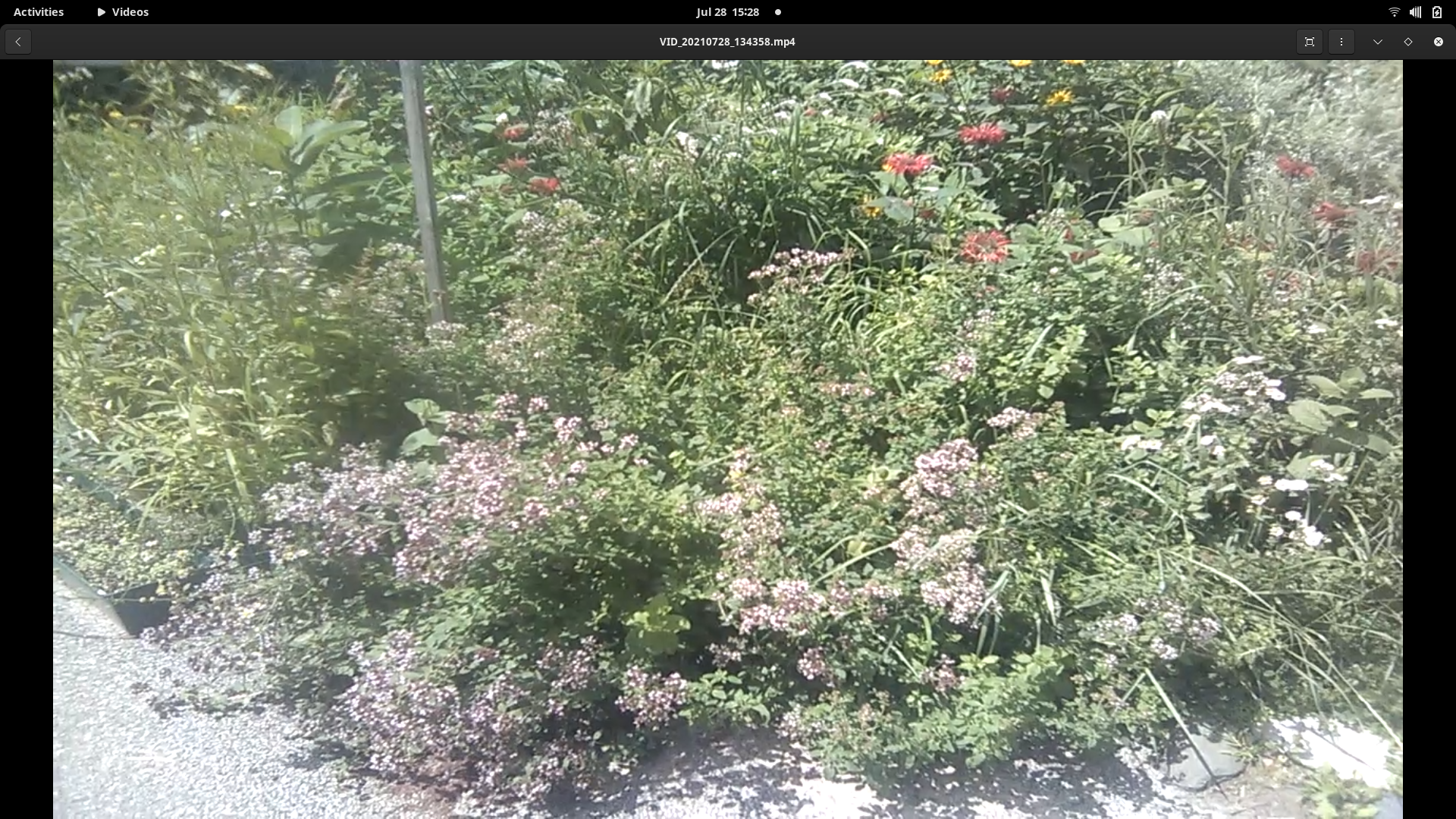

Still Think That Synthetic Fertilizers and/or Average Soils & Composts are the Way to Go?
THINK AGAIN.
As a Result of Natural & More Complete Decomposition of Highly-Beneficial Organic Matter, Vermicast Contains:
♦ More Essential Plant Nutrients, Macro (N-P-K) and Micro (Fe, Mg, B, Ca, Zn & more).
♦ Greater Bio-Availability of Those Essential Nutrients.
♦ More Natural Plant Growth Hormones (Gibberellins, Auxins, Humics, Salicylic Acid, and more).
♦ More Natural Vitamins.
♦ More Natural Antibiotics (and Related Compounds – like Flavonoids, Polyphenols, Lignans, Terpenoids, etc.).
♦ More Beneficial Micro-Organisms (Which Continue to Produce Natural Essential Nutrients, Vitamins, Antibiotics, etc., as They Continue to Feed on Beneficial Organic Matter).
All of Which Lead to Bigger, Stronger, Healthier Plants.
And Increased Fruit & Vegetable Production.
MOST Synthetic Fertilizers DON’T Contain the Essential Micro-Nutrients.
MOST Synthetic Fertilizers DON’T Contain Natural Antibiotics.
MOST Synthetic Fertilizers DON’T Contain Natural Plant Growth Hormones.
MOST Synthetic Fertilizers DON’T Contain Beneficial Micro-Organisms.
Most Other Soils & Composts (I.e. Animal Manure Based) Only Contain About 20 Percent Bio-Availability of Essential Nutrients.
Leading to More Runoff & Waste.
Plus Those Animal Manure Based Soils & Composts Often Lack the Natural Plant Growth Hormones, Natural Vitamins, Natural Antibiotics (and Related Compounds – like Flavonoids, Polyphenols, Lignans, Terpenoids, etc.) That are Necessary for Truly Healthy & Productive Plant Growth.
In Fact, One of the Best Things You Can do for Animal Manure Based Soils & Composts is to Add Vermicast, Which Will Feed On & Transform Those Into Higher-Quality Soils & Composts.
A Literal Grounds-Up Approach to Truly Healthy Plants.
Healthier Soils Produce Healthier Plants!
Soils & Castings:
PureSoil – Non-organic for flowers, Trees, Shrubs & non-consumables:
$5/gal
$25/cu. ft.
PureCast – Organic for produce, edibles, & consumables:
$7/gal
$35/cu. ft.
—————————————————————————————
Liquid Supplements:
100% Natural & Organic (NO added artificial or synthetic components).
■ Liquid Humics – Gentle, but power-packed liquid feed.
Natural Plant Growth Hormones (Gibberellins, Auxins, Salicin, etc.).
Macronutrients (N-P-K).
Micronutrients (Fe, B, Ca, Mg, Zn).
Beneficial Microorganisms.
Enzymes.
Rich in Humic & Fulvic Acids.
Shown to increase flower production.
Provides for better nutrient absorption by plants.
Pricing:
$15/gal.
■ Blackened Tan – 1/2 LiquidCast, 1/2 Liquid Humics.
Natural Plant Growth Hormones (Gibberellins, Auxins, Salicin, etc.).
Macronutrients (N-P-K).
Micronutrients (Fe, B, Ca, Mg, Zn).
Beneficial Microorganisms.
Enzymes.
Rich in Humic & Fulvic Acids.
Shown to increase flower production.
Provides for better nutrient absorption by plants.
Pricing:
$15/gal.
■ LiquidCast – Aka Worm Tea (Liquefied Castings).
Macronutrients (N-P-K).
Micronutrients (Fe, B, Ca, Mg, Zn).
Beneficial Microorganisms.
Enzymes.
Most of the goodness of vermicast in liquid form for easy feeding.
Provides fast nutrient absorption by plants.
Pricing:
$10/gal.
IT’S STILL NOT TOO LATE TO RESURRECT YOUR GARDENS & PLANTS!
Start seeds indoors now for big, beautiful Spring plants.
We have a small but specially-selected variety of seeds, chosen mostly for their beneficial uses, like herbal medicines, foods, seeds, pollinator attractants, and such.
These seeds are harvested from our own plants, which have been grown in our own vermicasts & organic amendments.
We get excellent germination rates, and healthy plants, and you should expect the same of these seeds.
We are also always happy to help by answering questions, supplying advice, or whatever we can do to ensure a beautiful, happy, healthy and productive garden.
Boutique Seeds n Such:
Heard the saying “You are what you eat”? That goes across the entire food chain. Better soils create better plants & flowers, which create better seeds.
Our seeds are harvested from our own plants which were grown in our own top-quality organic soils, which have been fed with our own top-quality feeds.
We typically see 90% – 100% germination rates. Check back as we’re adding varieties frequently.
Purple Cherokee Tomato – Purple Cherokee is a tomato that develops a fruit with a deep, dusky-rose color while maintaining a somewhat greenish hue near the stem when mature for eating.
Purple Cherokee tomatoes are beefsteak in style. They are also notable for having a dense, juicy texture. The comparatively dark interior color is enhanced by the tendency of the seeds to be surrounded by green gel.
This tomato is best enjoyed fresh and is often used in BLT sandwiches and salads. It can also be used when making pizza and pasta.
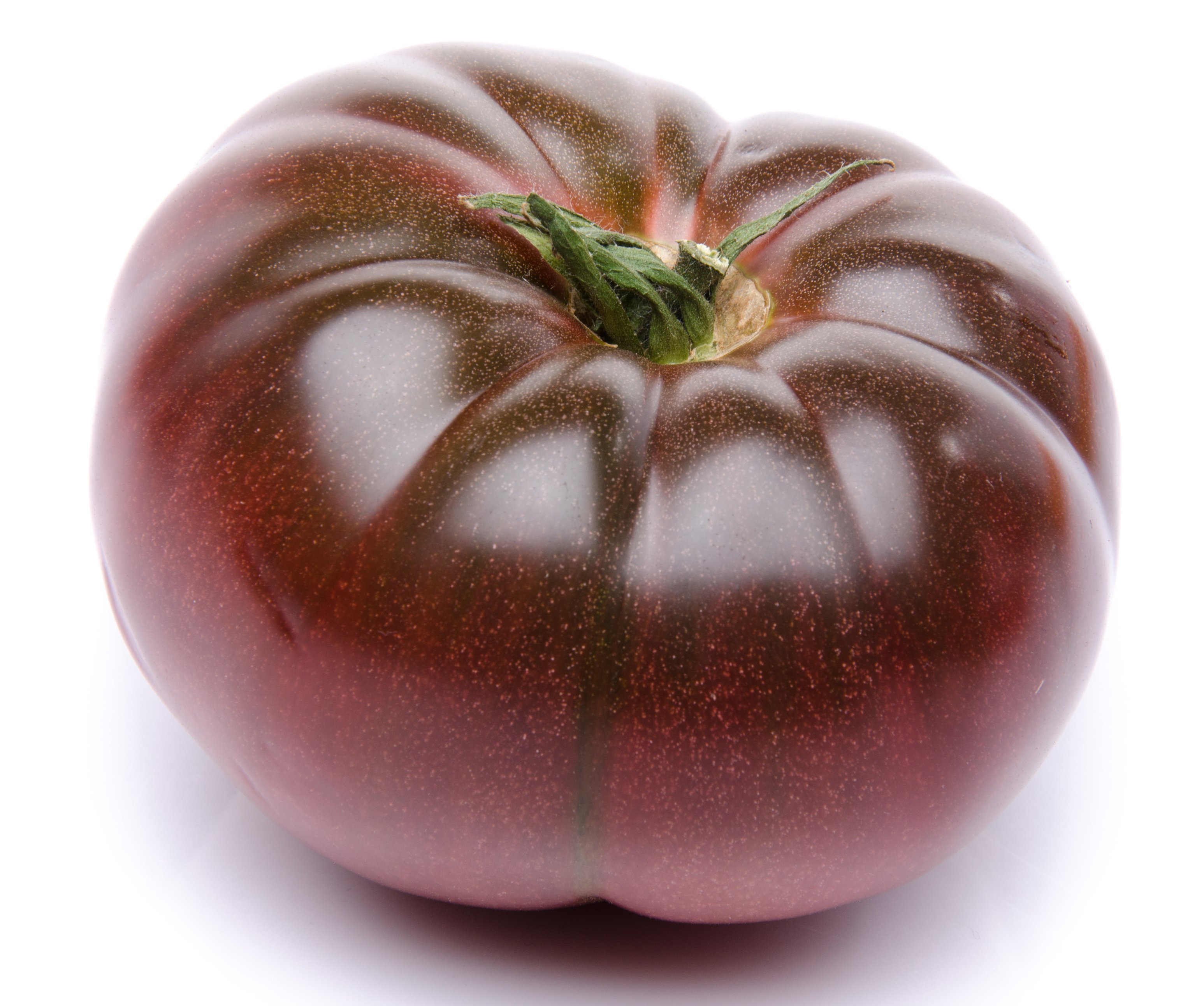
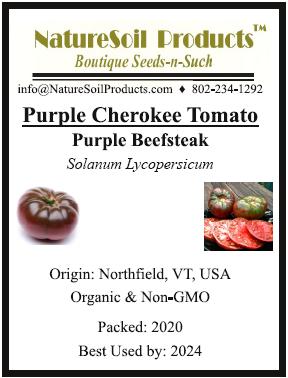
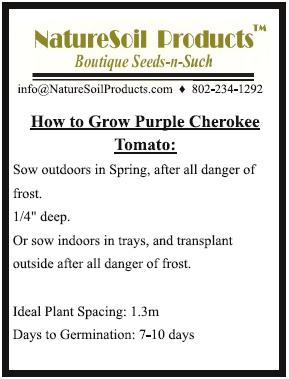
Black Cherry Tomato (Heirloom) – Once you try the Black Cherry Tomato, you won’t be able to stop!
This black tomato variety is really the only true black cherry tomato cultivator.
This tomato plant will produce huge yields in clusters of 1 inch, round, deep purple, almost black tomatoes.
The Black Cherry is an irresistibly delicious treat with sweet, rich, complex and full tomato flavors.

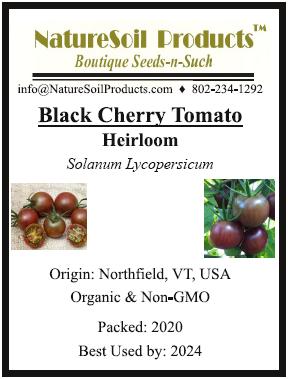

Sweet Orange Cherry Tomato – The Sweet Orange Cherry Tomato is one of the sweetest cherry tomatoes available.
This Sweet Orange Cherry Tomato plant will produce huge yields in clusters of 1 inch, round, bright orange tomatoes.
The Sweet Orange Cherry is an irresistibly delicious treat with sweet, rich, complex and full tomato flavors.
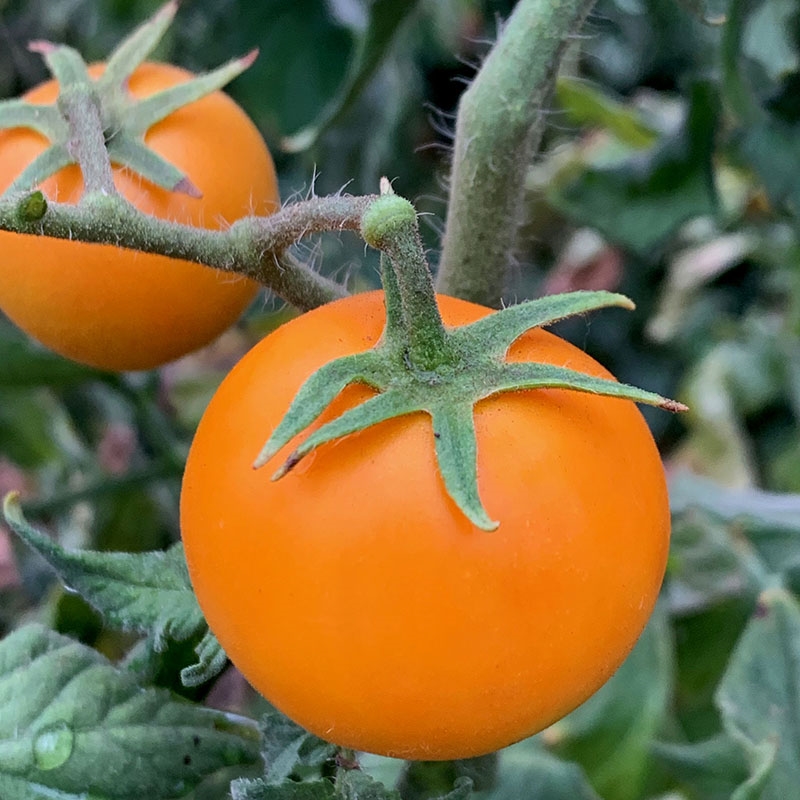
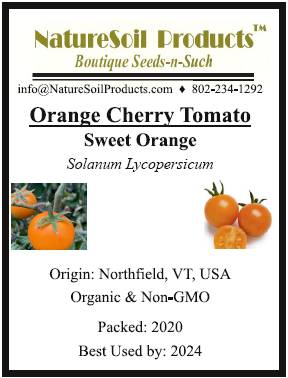
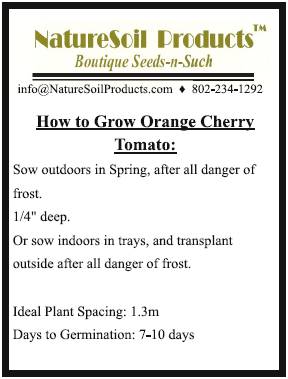
Sweet Red Grape Tomato – The Sweet Red Grape Tomato is tiny but packs a huge burst of sweetness.
This Sweet Red Grape Tomato plant will produce large yields in clusters of 1/2-1 inch, oval, bright red, tomatoes.
The Sweet Red Grape is an irresistibly delicious treat with sweet, rich, complex and full tomato flavors.


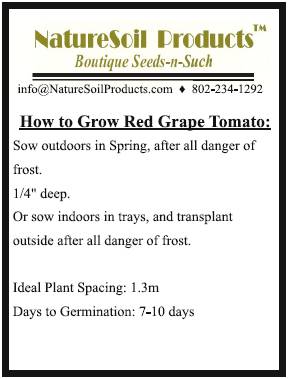
Mild Yellow Pear Tomato – This Mildly Sweet Yellow Pear Tomato plant will produce huge yields in clusters of 1-1/2 inch, pear-shaped, bright yellow tomatoes.
The Mildly Sweet Yellow Pear is an irresistibly delicious treat with mildly sweet, rich, complex and full tomato flavors.
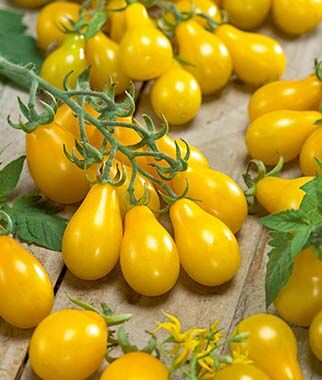
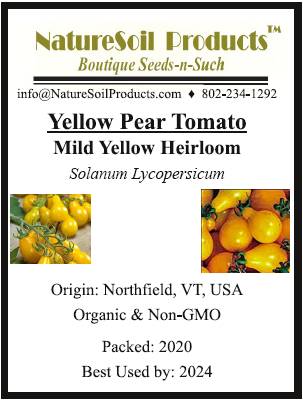

Flowering Tobacco (Nicotiana Alata) – Beautiful trumpet-shaped flowers in various colors. One of the most fragrant & sweetest-smelling flowers we’ve grown.
Over 2,500 seeds per pack.
A favorite of pollinators (numerous studies show that not only is the floral nicotine not harmful to pollinators, but that it is even beneficial, enabling quicker learning and perhaps protecting against parasitic pests).
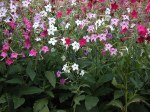
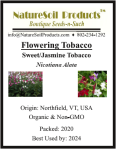

Morning Glory – Vining w/flowers of various colors.
Favored by Bees (mostly Bumble Bees).
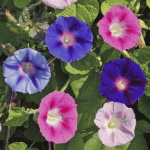


Sweet William (Pink – Dianthus barbatus) – a herbaceous biennial or short-lived perennial plant growing to 13–92 cm tall, with flowers in a dense cluster of up to 30 at the top of the stems. Each flower is 2–3 cm diameter with five petals displaying serrated edges.
Sweet William (Red – Dianthus barbatus) – a herbaceous biennial or short-lived perennial plant growing to 13–92 cm tall, with flowers in a dense cluster of up to 30 at the top of the stems. Each flower is 2–3 cm diameter with five petals displaying serrated edges.
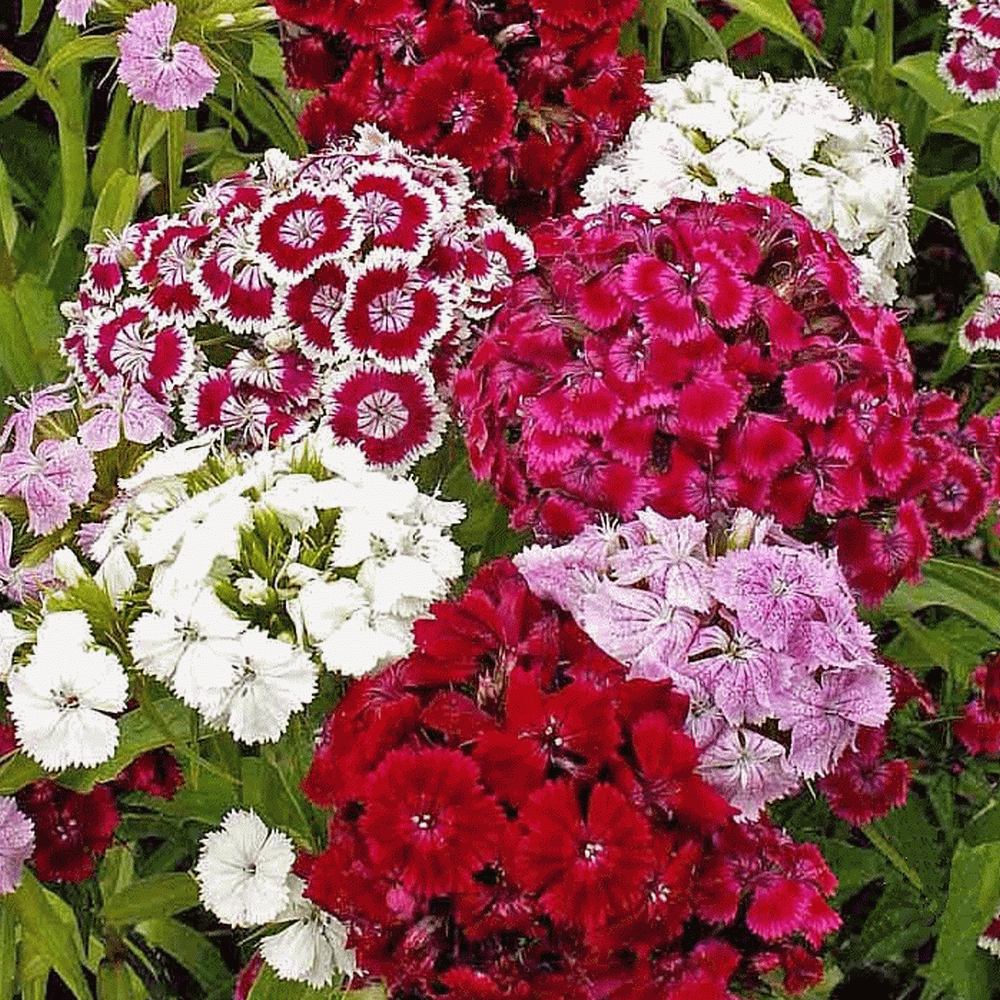
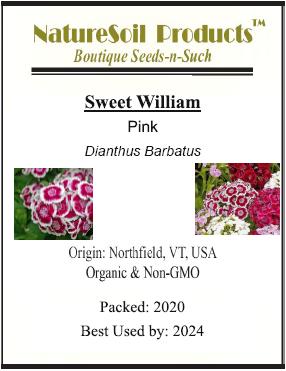
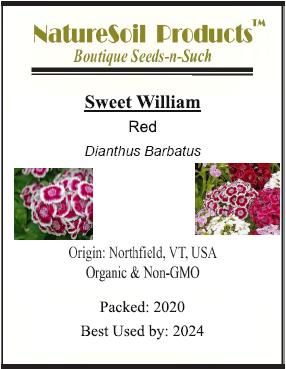
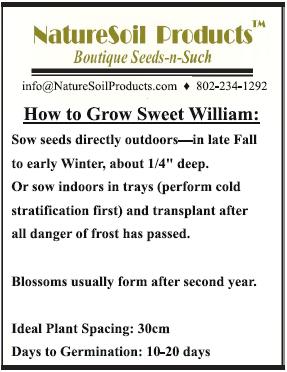
Yellow Mustard (Brassica Juncea) – Aka Brown Mustard, Indian Mustard.
Annual with small yellow flowers.
The leaves, seeds, and stems of this mustard variety are edible.
The mustard condiment made from the seeds of the B. juncea is called brown mustard and is considered to be spicier than yellow mustard.
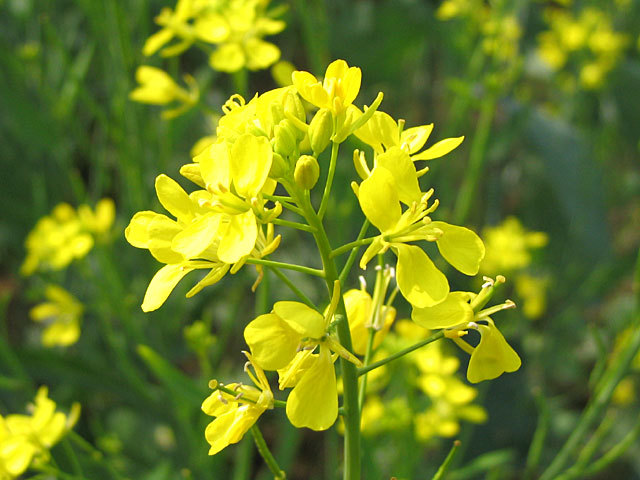
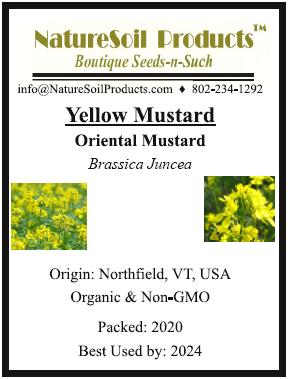
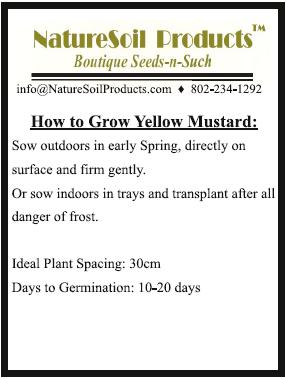
Golden Flax (aka Linseed) – Flax is cultivated as a food and fiber crop in cooler regions of the world.
Flax is also grown as an ornamental plant in gardens, with often blue to purple flowers.
Flax seed can be used whole, ground down to a powder or sprouted. Flax sprouts are known for their spicy taste.
A 100-gram portion of ground Flax seed supplies about 534 calories (2,230 kJ), 41 g of fat, 28 g of fiber, and 20 g of protein.
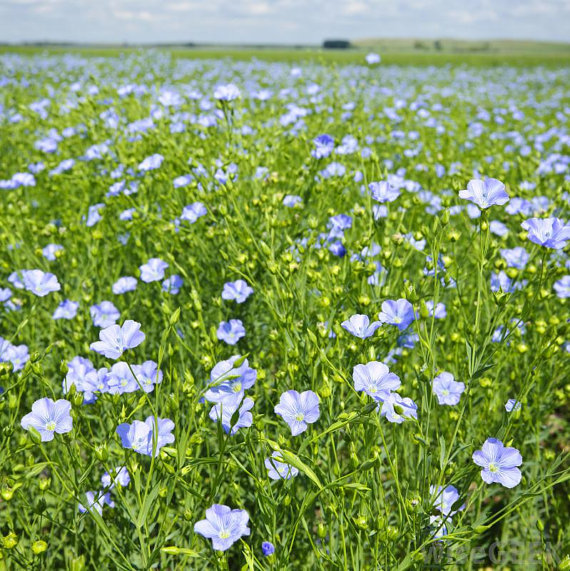


Purple Hyacinth Bean (aka Jefferson Bean)– Vining with purple flowers. Flowers and beans are edible. Used as a substitute for Soy in making tofu for those with soy allergies.

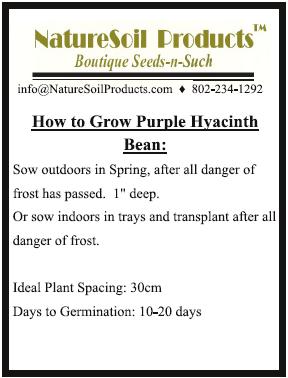
Breadseed Poppy (aka Florists Poppy, Papaver Somniferum) – Annual with mostly papery purple flowers. Pods can be used in cut or dried floral arrangements.
Seeds are edible, and often used in baking, in salads, sprinkled into cereal or oatmeal, and other culinary uses.



Corn Poppy (aka Flanders Poppy, Papaver Rhoeas) – Annual with mostly papery red flowers. Pods can be used in cut or dried floral arrangements.
Seeds are edible, and often used in baking, in salads, sprinkled into cereal or oatmeal, and other culinary uses.


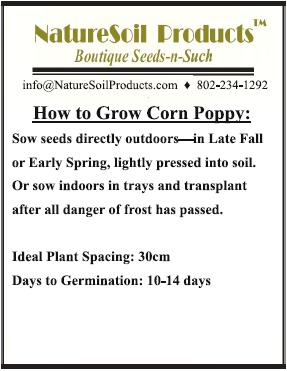
Daisy – A classic flower.

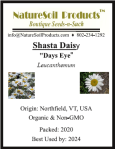

Milkweed (aka Silkweed, Monarch Butterfly Plant) – Necessary as food for Monarch butterflies. Researchers have identified the reduction in Milkweed plants as the main cause in the ongoing vast loss of Monarch butterflies. Perennial.
Young leaves can be cooked (steamed) and eaten.



Burdock (aka Little Burdock, Wild Rhubarb) – Flowing biennial in the daisy family with prickly flowers that are pink to lavender in color. Flower heads are about 2 cm (0.79 in) wide. blooming from mid to late summer.
You may wonder why anyone would willingly plant this “weedy” plant.
The leafstalks (a year old or younger) and flower stalks can be eaten raw or cooked.
The seeds can be eaten, raw or roasted, or used as bird seed.
The roots are edible boiled with a change of water, and can be pickled or added to stir-fry.
Burdock & Dandelion is a beverage consumed in the British Isles since the Middle Ages, and possesses numerous medicinal qualities.
Bees and other beneficial pollinators love these flowers.



Purple Coneflower (aka Echinacea) – Herbaceous flowing perennial in the daisy family with large, showy heads of composite flowers blooming from early to late summer.
Frequently used in folk medicine to boost immunity.

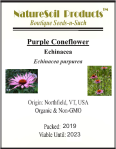

Cutleaf Coneflower – “Golden Glow” – Herbaceous flowing annual to perennial in the sunflower family with large, showy heads of composite flowers blooming from early to late summer.
The “Golden Glow” variety has yellow flowers and a pronounced yellow to greenish cone.
The young leaves can be gathered and eaten in the early spring. They are greatly favored as a potherb (cooked). Some references state the use of this plant as salad greens (raw).

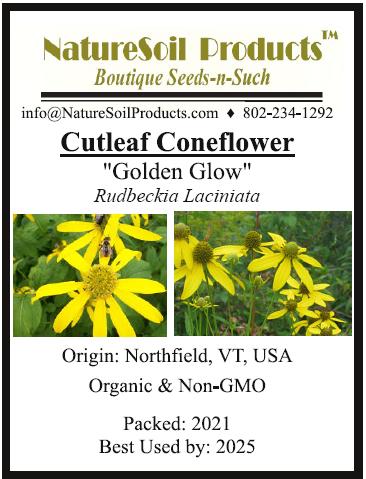

Black-Eyed Susan – “Moreno” – Herbaceous flowing annual to perennial in the sunflower family with large, showy heads of composite flowers blooming from early to late summer.
The “Moreno” variety has mahogany-red fading to orange-tipped ray flowers and a pronounced dark purple to black cone.
Roots have been used in folk medicine to boost immunity.

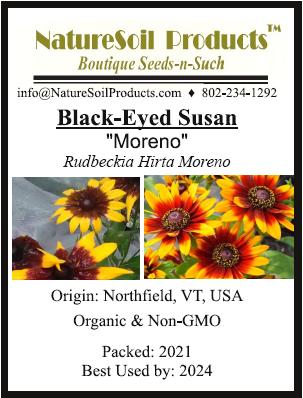

Black-Eyed Susan – “Indian Summer” – Herbaceous flowing annual to perennial in the sunflower family with large, showy heads of composite flowers blooming from early to late summer.
The “Indian Summer” variety has yellow flowers and a pronounced dark purple to black cone.
Roots have been used in folk medicine to boost immunity.



New England Aster (aka Michaelmas Daisy) – Herbaceous flowering perennial. abundant flower heads are showy with yellow disc florets at the center and ray florets that range from a deep purple or rose pink to rarely white. A favorite of pollinators.




Cornflower (aka Bachelor’s Button) – An annual plant growing to 40–90 cm tall, with grey-green branched stems.
The flowers typically range in color from blue, pink, lavender, and white, produced in flowerheads 1.5–3 cm diameter, with a ring of a few large, spreading ray florets surrounding a central cluster of disc florets.
The edible flower of the cornflower can be used for culinary decoration, for example to add color to salads.
Cornflowers have been used historically for their colorful pigment.
Cornflowers are often used as an ingredient in some tea blends and herbal teas.



Cosmos – Herbaceous perennial or annual plants growing 0.3–2 m (1 ft 0 in–6 ft 7 in) tall.
The leaves are simple, pinnate, or bipinnate, and arranged in opposite pairs. The flowers are produced in a capitulum with a ring of broad ray florets and a center of disc florets; flower color is variable but frequently pink, scarlet, white, and red.
Smaller birds love to sit on Cosmos stems and eat the seeds in Fall.

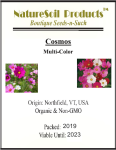

Pricing:
$2.50/packet.
More to come…….
NatureSoil Products™ – Born of Nature. Back to Nature.
You are what you eat.
Garbage in equals garbage out.
“Let food be thy medicine and medicine be thy food”
Globally it has been estimated that some 50%-70% of pharmaceuticals are synthesized, or based on natural allelochamicals.
Aspirin, for example, acetylsalicylic acid is based on Salicylic Acid, which comes from Salicin in the bark of the Salix genus of trees (and other plants).
Allelopathy is a biological phenomenon by which an organism produces one or more biochemicals that influence the germination, growth, survival, and reproduction of other organisms. These biochemicals are known as allelochemicals and can have beneficial (positive allelopathy) or detrimental (negative allelopathy) effects on the target organisms and the community. Allelochemicals are a subset of secondary metabolites, which are not required for metabolism (i.e. growth, development and reproduction) of the allelopathic organism. Allelochemicals with negative allelopathic effects are an important part of plant defense against herbivory.
When people talk about herbal medicine, whether they know it or not, they’re talking about the allelochemicals that are in those herbs.
But it has been my personal experience that synthetic pharmaceuticals don’t offer as many advantages as their wholesome natural counterparts.
Most all natural antibiotics known to humans are created by microbes, typically soil microbes.
They are a type of germ warfare, created by microbes to fight off other microbes.
Plants use these to ward off disease and infection just as animals and humans do.
And, given their natural development, they mutate/evolve in response to mutations/evolutions of those microbes.
Thus they avoid the same consequences of encountering antibiotic resistance as do synthetic pharmaceuticals, which aren’t created in a natural state, thus don’t naturally evolve.
The production of allelochemicals are also affected by biotic factors such as nutrients available, and abiotic factors such as temperature and pH.
But they are often labeled as mere quackery by the medical and pharmaceutical industries.
You generally can’t patent natural products.
And patents offer protection from competition, thus create greater profit.
If more people began using more affordably-priced natural alternatives, even growing their own (I grow a nice-sized traditional herbal medicinal garden) the pharmaceutical industry would lose much profit.
And this is exactly why we do what we do.
We create the highest-quality soils, utilizing those natural beneficial microbiotic processes.
Vermicast (worm manure) is natural topsoil.
But it’s way beyond just mere soil.
Have you ever stopped to consider what makes some soils different than others?
Have you ever stopped to consider where many vitamins comes from?
What about natural antibiotics?
Or flavonoids, which create “taste” and “flavor”?
Or enzymes, which are necessary catalysts for cell production?
The answer to all the above is, soil microorganisms.
Bacteria and fungi.
Plus, bacteria and fungi make up a large part of the diets of earthworms.
Thus vermicast is generally fuller and richer in vitamins, natural antibiotics, flavonoids, and enzymes.
All the things that make food great.
Many vitamins are either created, or bioactivated by processes involving interactions of bacteria and fungi, often in conjunction with enzymes.
Even where it was once thought that Vitamin D was created by the skin from sunlight, more recent studies and research is showing it is actually the microbiome on & in the skin that is synthesizing that vitamin D (it’s been shown that for every human skin cell, there are some 9 microorganisms present).
Most all natural antibiotics known to humans are created by soil microorganisms, often in conjunction with enzymes.
Those natural antibiotics are defense mechanisms, a form of chemical warfare as groups of microorganisms battle other groups of microorganisms.
Plus, whereas antibiotic resistance among bacteria from lab-created antibiotics has become a major concern, natural antibiotics undergo rapid evolutions, mutations in response to evolving & mutating bacteria, as they develop a resistance to former antibiotics.
Nature responds to natural changes.
But humans can’t keep up in the lab.
Flavonoid production too has been shown to originate via the aid of bacteria and fungi.
In particular, E. coli has been studied, and used, extensively for it’s ability to synthesize flavonoids.
Plant flavonoids continue to find increasing use in pharmaceutical and nutraceutical applications.
Flavonoids are a type of polyphenol, often known as “bitters” and/or “aeromatic compounds”.
These bitters/aeromatic compounds have been used extensively throughout history in herbal & natural medicines (consider the use of Quinine against Malaria, or Eucalyptus against bronchial and sinus problems).
Enzymes too are created by microorganisms.
Enzymes are proteins that exist within cell walls.
Almost all metabolic processes in the cell need enzyme catalysis in order to occur at rates fast enough to sustain life.
It has often been said that the ancient “Father of Medicine, Hippocrates, said:
“Let food be thy medicine and medicine be thy food.”
Though this has also been frequently cited as being misattributed to Hippocrates, in line with Hippocrates’ philosophy, there is a complementarity of nutrition and pharmacology.
Some prefer to phrase it as “You are what you eat”.
Better building blocks equals better structures.
Foods that are richer in vitamins, natural antibiotics, flavonoids, and enzymes are much healthier than those lacking, or without.
Going back to that adage, “You are what you eat”, that goes across the entire food chain.
Better & healthier microorganisms create better soils.
Better soils create better & healthier plants.
Better & healthier plants create better & healthier bodies.
Everything is interconnected.
That is the main philosophy behind NatureSoil Products, and the high-grade products we create.
Sewage sludge is quickly becoming one of the main inputs used in soils & composts, even those used on farmlands & gardens.
Sewage sludge, aka Biosolids, is a product of wastewater treatment.
These separated processed solids – sewage sludge – contain numerous known and unknown hazardous materials. This includes everything that is flushed into the sewer system, including: household, medical, chemical, and industrial waste; chemicals and metals that leach from the sewer pipes themselves; and novel materials that are created in the wastewater treatment plant as a result of the combination of chemicals and organic compounds present.
That’s right – these Biosolids, often full of toxic compounds, nanomaterials, hormones, and dangerous pathogens, are applied to the very food we eat. While certain sanitation processes do decrease some health risks, chemicals such as PCBs, flame retardants, heavy metals, and endocrine disrupters – many of which are carcinogens – are not filtered out. Instead, they accumulate in the soil and are taken up by crops, putting human health at risk.
Worse, companies don’t have to disclose when sewage sludge is used in their compost and soil products.
Still worse, these companies can, and often do market those products as “organic”.
Why?
1. Soils and composts are excluded from the USDA’s strict regulations on the use of the term “organic”.
2. These companies use the chemical definition of the term “organic” – simply meaning containing carbon.
The corporatization of agriculture means that fewer and fewer people (acting through corporations) are controlling more and more of our food production. One of the symptoms of this corporate takeover is the land application of sewage sludge on croplands.
The EPA and big Agri-Corporations claims it is safe because toxic pollutants are limited, yet, three pollutant limits are still above safe landfill boundary levels.
Not only that, but EPA only directly addresses 8 out of 126 priority toxic pollutants in Class A “Exceptional Quality” sludge fertilizer, which have all been identified to cause death, disease, cancer, etc., either by direct exposure or indirect exposure through the food chain.
Safe?
The EPA is now actively & aggressively pushing the Biodigester industry.
Here in Vermont, with the enactment of the new Universal Recycling Act (Act 148), grants are being used to support this industry.
Vermont’s Universal Recycling Act (Act 148) even states that it seeks to promote the use of sewage sludge as a beneficial amendment, stating:
(2) its value as a soil amendment (p. 12).
And:
(8) actions which can be taken through existing state programs to
facilitate beneficial use of septage and sludge (p. 13).
One of the biggest problems to arise from this ill-conceived legislation will be the convoluted nature of the true contents of composts and soils.
• Most sewage sludge is now sent to specialty third-party processors, to be included & used in Biodegesters.
• These third-party processors will mix together any number of wastes, including vegetative, animal manures, and sewage sludge.
• The resultant end-product, anaerobically digested wastes, which becomes unrecognizable, is then sent to soil & compost facilities and companies, whom then mix that product with other products, like ground forest products, and bag them.
Thus many compost companies and facilities don’t even know what all is in the input materials they receive from these third-party processors.
Their products are also then mostly sent to & sold by retailers, whom remain completely ignorant of the true contents of those soils & composts.
Out of sight, out of mind?
Ignorance is bliss?
Plausible deniability?
For further reading:
Table 1 Typical nutrient concentrations in NatureSoil Products Mineral Powder and FutureSoil™ Soil Conditioner (dry weight basis).
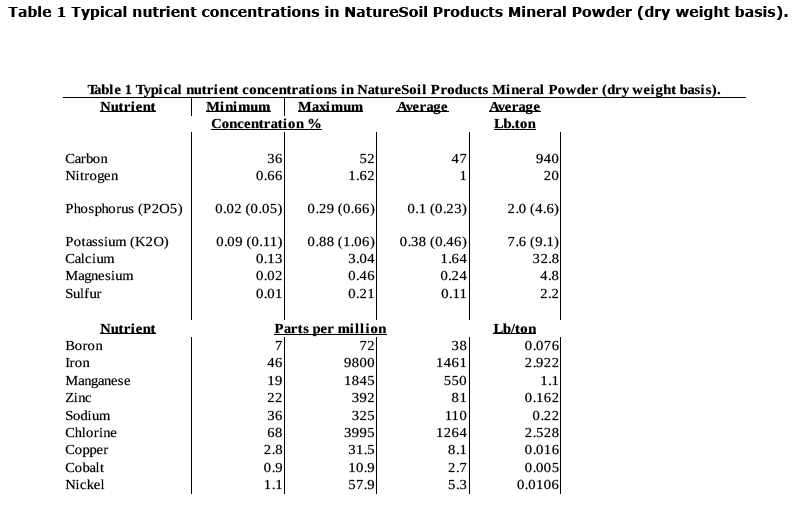
Three years of application caused no decrease in the soil pH compared to unamended soils.
Biosolids, Sewage Sludge, Soils, Composts and Soil Amendments:
Not all composts and soil amendments are equal, and not all composts and soil amendments labeled as “organic” are permitted for use on organic farms and gardens.
Many soils and composts are labeled as “organic”, but do not meet the USDA’s National Organic Program (NOP) rules for organic gardening, farming, or growing.
The term “organic” has two very different legal definitions, thus making it convoluted:
1) “Organic” in agricultural terms (relating to food production, not compost) means produce and food products conform to strict USDA/NOP organic rules & regulations, meaning growers can’t use certain products, like sewage sludge, fertilizers or synthetic substances, to grow their produce.
2) “Organic” in chemical terms simply means something that contains carbon. Much of the compost industry uses this chemical definition, since they don’t have to comply with USDA/NOP standards, and to fool consumers. Since human excrement (sewage sludge) does contain carbon, the compost industry can legally call it “organic”, though it can’t be used to grow USDA/NOP certified organic produce.
In regards to organically grown and designated produce and food products, the USDA operates the National Organics Program (NOP). The USDA regulates what can and can’t be used in organic growing. Food and produce cannot be labeled as “organic” unless in conforms to USDA/NOP regulations.
Sewage sludge (“biosolids”) is not a USDA/NOP approved amendment for organic food and produce production, it is strictly prohibited for organic growers. It is however widely used in non-organic food and produce production.
The USDA does not regulate the compost industry, only the food (ag) industry. Compost can therefore legally be labeled “organic” despite containing sewage sludge. Compost can also contain non-organic fertilizers and still be labeled as “organic”. However, compost labeled “organic” that contains sewage sludge (or prohibited fertilizers), cannot be used to grow USDA/NOP certified organic food and produce. The “organic” label is just a slick marketing tactic used by much of the compost industry to trick consumers into thinking they’re conforming to organic practices & guidelines, when in fact they’re not. Out of sight, out of mind is their method.
The commercial compost and soil (top soil, potting soil, etc.) industry has become a dumping ground for the wastewater treatment industry, in their desperation to dispose of sewage sludge.
Consider all the nasty stuff that passes through the human body, including pharmaceuticals, chemicals, pathogens, heavy metals; and the stuff that is flushed down toilets, sinks, drains, etc., like makeup, household cleaning chemicals, motor oils, antifreeze, solvents, industrial wastes, etc.
This is all ending up in wastewater treatment plants, filtered out of the water as a sludge, treated, then distributed to soil and compost makers.
In the past, communities around the world used the ocean for waste disposal, including the disposal of sewage sludge. Little attention was given to the negative impacts of waste disposal on the marine environment.
Following decades of uncontrolled dumping, some areas of the ocean became demonstrably contaminated with high concentrations of harmful pollutants including heavy metals, inorganic nutrients, and chlorinated petrochemicals. The uncontrolled ocean dumping caused severe depletion of oxygen levels in some ocean waters.
A 1970 Report to the President from the Council on Environmental Quality on ocean dumping described that in 1968, 4.5 million tons of sewage sludge (significantly contaminated with heavy metals) were dumped in the ocean in the United States.
In October 1972, Congress enacted the Marine Protection, Research and Sanctuaries Act (MPRSA), sometimes referred to as the Ocean Dumping Act, declaring that it is the policy of the United States to regulate the dumping of all materials which would adversely affect human health, welfare or amenities, or the marine environment, ecological systems or economic potentialities.
The MPRSA and EPA’s ocean dumping regulations prohibit ocean dumping of certain materials, including sewage sludge.
All that sewage sludge has to be disposed of somewhere. Municipal wastewater treatments plants, finding it too expensive to dispose of this sewage sludge in landfills, began lobbying state Legislatures to allow the inclusion of this sludge in soils and composts.
Yet now, after decades of application, several studies have shown that soils receiving human manures were enriched in antibiotic-resistant bacteria and various antibiotic resistance determinants.
One such study concluded that “The increasing prevalence of antibiotic-resistant bacteria is one of the most serious threats to public health in the 21st century.
One route by which resistance genes enter the food system is through amendment of soils with manure from antibiotic-treated animals [including humans], which are considered a reservoir of such genes”.
NatureSoil Products contain absolutely no human excrement, sewage sludges, “Biosolids, or other possibly harmful ingredients.
NatureSoil Products are 100% veganic-derived soils and amendments.
Soil Erosion
macronutrients to the soil, NatureSoil Products return Macronutrients; Micronutrients; Necessary minerals like calcium, iron, magnesium, selenium, and many others; Enzymes; Natural plant growth hormones; And beneficial microorganisms (biota). NatureSoil Products deliver greater bioavailability of all nutrients compared to fertilizers and composts.
about the same rate as it erodes. Naturally, as a tree or leaves fall, or as plants die, natural organisms eat that dead vegetation decomposing it back into natural
topsoil. Human activity has been the main cause of erosion dating back to the first millenium. Human activity causes 10 times more soil erosion than all natural
processes combined. Agriculture, construction, and landfill waste are the main sources of human caused erosion. In the U.S., soil erosion occurs at 10 times the
rate at which topsoil is naturally replaced. With human activity, trees are cut down and processed into paper, cardboard, etc. and often disposed of into landfills.
Even when recycled into other paper products, that wood pulp is not returned to the ground as topsoil. As lawns are mowed and fallen leaves are raked, they are
most often bagged and disposed of as garbage, ending up in landfills. Again, that vegetation is not allowed to naturally decompose back into topsoil.
existing matter extracted from the earth’s soil, water, and atmospheric gasses like carbon dioxide. Every ounce of new vegetative matter that grows consumes an
equal amount of pre-existing matter, much of that coming from soil. Human activities such as farming, lawn mowing, shrub pruning, weeding, etc., when those
vegetative matters are removed from their source, all cause soil erosion. The United States throws away up to 40% of all it’s food produced, with the majority of that
food going to landfills, displacing that vegetative matter, and causing erosion.
Landfills rely on an extremely slow, anaerobic decomposition process that produces greenhouse gasses like methane and carbon dioxide. Landfills cause both air pollution and water pollution. Studies have shown that people living close to landfills suffer from lung and heart diseases from the toxic gasses that are released from the landfill degradation. Seemingly harmless materials, such as yard waste, paper products, food waste, etc., when combined with the other materials disposed of in landfills (metals, batteries, pharmaceuticals, cosmetics, plastics, etc.) combine to create a toxic leachate. Groundwater contamination may result from leakage of very small amounts of leachate. TCE is a carcinogen typically found in landfill leachate. It would take less than 4 drops of TCE mixed with the water in an average swimming pool (20,000 gallons) to render the water undrinkable. Some surveys conducted have shown that 82% of the landfills have leaks and up to 41% of the landfills had a leak area of more than one square foot. EPA sponsored research shows that burying household garbage in the ground poisoned the ground water. The EPA has stressed that, even with the double liner landfills, the probability of leaking is very high. According to EPA estimates a 100-acre landfill in the northeastern United States can produce 57 million gallons of leachate every year. The largest landfill in the world – Fresh Kills, in Staten Island, NY – is over 2965 acres, and produces 4 million gallons of leachate per day, or 1.5 billons gallons per year.
biosolids that are left over from human waste that is removed from sewage water. Sewage sludge is known to contain not only large concentrations of toxic heavy
metal, but also dangerous disease bearing pathogens like E. coli, Salmonella, norovirus, and a host of other contaminants. Sludge is also known to contain
measurable levels of environmentally persistant chemicals such as polychlorinated biphenyls, dioxins, asbestos, PCBs, and hundreds of other toxins. Residual
pharmaceuticals and human hormones are among the other dangers of contaminants contained within sludge.
municipalities to begin disposing of it in landfills. Given the relative difficulty cities and municipalities have faced in disposing of this growing waste problem,
several companies embraced and began marketing it as a “nutrient rich” fertilizer. Biosolids were presented as a no to low cost alternative for farmers. This
process of spinning and rebranding sludge into beneficial fertilizer is well documented by authors John Stauber and Sheldon Rampton in their book, Toxic Sludge is
Good for You.
spinach, cabbage, Swiss chard, and carrots have all been shown to accumulate toxic metals and/or toxic chlorinated hydrocarbons when grown on soils treated with
sewage sludge. In some instances, toxic organics contaminate the leafy parts of plants by simply volatilizing out of the sludge. Small mammals have been shown to
accumulate heavy metals after sewage sludge was applied to forest lands.
including hydrologists for the U.S. Geological Survey, tested an eastern Colorado wheat field that used treated sludge from a Denver sewage treatment plant.
Chemicals in antibacterial soaps, cleaners, cosmetics, fragrances and prescription drugs such as Prozac and Warfarin not only persisted in the topsoil, but migrated
downwards.
contaminants after digestion, we feel there is no solid evidence that worm fed composted sludge material is any safer, or fit as a fertilizer. Beware! Many
inexpensive or value-priced brands of vermicast & vermicompost products are produced using sewage sludge.
NatureSoil Products™ are derived from 100% natural vegetative matter, and contain no sludge, or added chemical or synthetic components.
NatureSoil Products™ – Born of Nature. Back to Nature.
losses result from the intense microbial activity in their gut, and from their own metabolic activity. Eg. The elimination of N due to fast turnover of this element in microbial biomass. A significant proportion of C assimilated by earthworms is secreted as intestinal and cutaneous mucus with greater C:N ratios than those of the resource used (Lavelle et al., 1983; Cortez and Bouche, 1987).
spectrum is quite different and also much more beneficial in a vermicompost. I mean, I will stick by what I have said a number of times that a vermicompost is much, much preferable to a compost if you’re going in for a plant-growth medium.”
The authors go on to say that the pathogen suppression disappeared when the vermicompost was sterilized, indicating that the mechanism involved was microbial antagonism. In recent research, Edwards and Arancon (2004) report statistically significant decreases in arthropod (aphid, mealy bug, spider mite) populations, and subsequent reductions in plant damage, in tomato, pepper, and cabbage trials with 20% and 40% vermicompost additions to Metro Mix 360 (the control). They also found statistically significant suppression of plant-parasitic nematodes in field trials with peppers, tomatoes, strawberries, and grapes. Much more research is required, however, before vermicompost can be considered as an alternative to pesticides or alternative, non-toxic methods of pest control.
which they do with the help of Enzymes.
For over 125 million years, the earth has sustained itself by recycling organic, enzyme-rich substances. As animals, insects, worms, micro- and other organisms consume plant matter, they also consume the enzymes of that plant matter, and rely on those enzymes for proper health, growth and development.
Synthetic, chemical, enzymeless fertilizers were developed about 50 or 60 years ago. These fertilizers often rely solely on N-P-K nutrients, ignoring the necessary interactions between all biological compounds of healthy plant cell growth and development.
Shortly, after the introduction of and increased use of synthetic, chemical, enzymeless fertilizers, plants began weakening, could not hold their own, and began to be attacked and afflicted with numerous ailments which had been no real problem when natural, organic enzyme fertilizers were used. Lower resistance to disease, damage, and stress have been among the consequences.
The chemical and synthetic enzymeless fertilizer substitutes weaken vegetables and other food plants, building up a hidden preclinical entity, a state of “disease” that is a prelude to disease. Modern crops cannot stand on their own in the absence of adequate supplies of enzymes.
This weak state of fruit, vegetable, and produce food can be a factor in many serious human diseases. Though there is still much research to be done regarding vitamin synthesis in plants, vegetables, fruits, and other produce, several recent studies have shown vitamins are likely metabolized by a reaction involving enzymes. Studies have shown decreasing levels of vitamins and other nutrients in produce grown today versus produce grown just 50 years ago. Fewer enzymes, vitamins and minerals in produce means less nutrition available to humans and animals. These substances are essential to healthy growth, development, and immunity support.
Adequate bacteria and fungal populations are essential in helping to break down organic matter. These bacteria and fungi help produce enzymes, which assist in breaking down fallen leaves, bark, dead plant material, and other organic matter, freeing available nutrients (as in nitrogen-fixing), which the fungi & bacteria can then more easily digest and metabolize. For example, the enzyme Phosphatase works to break down Phospate, which is a mineral, into simpler forms such as OrthoPhosphate. Plants
Humic substances are a good source of energy for beneficial soil organisms. Humic substances and non humic (organic) compounds provide the energy and many of the mineral requirements for soil microorganisms and soil animals. Beneficial soil organisms lack the photosynthetic apparatus to capture energy from the sun thus must survive on residual carbon containing substances on or in the soil. Energy stored within the carbon bonds functions to provide energy for various metabolic reactions within these organisms. Beneficial soil organisms (algae, yeasts, bacteria, fungi nematodes, mycorrhizae, and small animals) perform many beneficial functions which influence soil fertility and plant health. For example the bacteria release organic acids which aid in the solubility and bioavailability of mineral elements bound in soil. Bacteria also release complex polysaccharides (sugar based compounds) that help create soil crumbs (aggregates). Soil crumbs give soil a desirable structure.
Other beneficial soil microorganisms such as the Actinomyces release antibiotics into the soil. These antibiotics are taken up by the plant to protect it against pests. Antibiotics also function to create desirable ecological balances of soil organisms on the root surface (rhizoplane) and in soil near the roots (rhizosphere). Fungi also perform many beneficial functions in soils. For example, mycorrhizae aid plant roots in the uptake of water and trace elements. Other fungi decompose crop residues and vegetative matter releasing bound nutrients for other organisms. Many of the organic compounds released by fungi aid in forming humus and soil crumbs. Beneficial soil animals create tunnel like channels in the soil. These channels allow the soil to breath, and exchange gases with the atmosphere. Soil animals also aid in the formation of humus, and help balance the concentration of soil microorganisms. A healthy fertile soil must contain sufficient carbon containing compounds to sustain the billions of microscopic life forms required for a fertile soil and a healthy plant.
A living soil is a fertile, healthy soil.
The urgency to emphasize the importance of humic substances and their value as fertilizer ingredients has never been more important than it is today. All those concerned about the ability of soils to support plant growth need to assist in educating the public. Humic substances are recognized by most soil scientists and agronomists as the most important component of a healthy fertile soil.
To illustrate how humic substances and hormones function, the following summary, based on published scientific data, has been prepared as a guide for an educational program. In addition, by understanding how these carbon containing substances function, professionals will have a solid foundation on which to design environmentally acceptable sustainable agriculture programs.
HUMIC SUBSTANCES AND THEIR INFLUENCE ON SOIL FERTILITY
Humic substances are a good source of energy for beneficial soil organisms. Humic substances and non humic (organic) compounds provide the energy and many of the mineral requirements for soil microorganisms and soil animals. Beneficial soil organisms lack the photosynthetic apparatus to capture energy from the sun thus must survive on residual carbon containing substances on or in the soil.
Energy stored within the carbon bonds functions to provide energy for various metabolic reactions within these organisms. Beneficial soil organisms (algae, yeasts, bacteria, fungi nematodes, mycorrhizae, and small animals) perform many beneficial functions which influence soil fertility and plant health. For example the bacteria release organic acids which aid in the solubility and bioavailability of mineral elements bound in soil. Bacteria also release complex polysaccharides (sugar based compounds) that help create soil crumbs (aggregates). Soil crumbs give soil a desirable structure. Other beneficial soil microorganisms such as the Actinomyces release antibiotics into the soil. These antibiotics are taken up by the plant to protect it against pests. Antibiotics also function to create desirable ecological balances of soil organisms on the root surface (rhizoplane) and in soil near the roots (rhizosphere). Fungi also perform many beneficial functions in soils. For example, mycorrhizae aid plant roots in the uptake of water and trace elements. Other fungi decompose crop residues and vegetative matter releasing bound nutrients for other organisms. Many of the organic compounds released by fungi aid in forming humus and soil crumbs. Beneficial soil animals create tunnel like channels in the soil. These channels allow the soil to breath, and exchange gases with the atmosphere. Soil animals also aid in the formation of humus, and help balance the concentration of soil microorganisms. A healthy fertile soil must contain sufficient carbon containing compounds to sustain the billions of microscopic life forms required for a fertile soil and a healthy plant. A living soil is a fertile healthy soil.
DEVELOPMENT
A study on the effects of humic acid on plant growth was conducted at Ohio State University which said in part “humic acids increased plant growth” and that there were “relatively large responses at low application rates”.
Plant growth is influenced indirectly and directly by humic substances. Positive correlations between the humus content of the soil, plant yields and product quality have been published in many different scientific journals. Indirect effects, previously discussed, are those factors which provide energy for the beneficial organisms within the soil, influence the soil’s water holding capacity, influence the soil’s structure, release of plant nutrients from soft minerals, increased availability of trace minerals, and in general improved soil fertility. Direct effects include those changes in plant metabolism that occur following the uptake of organic macromolecules, such as humic acids, fulvic acids. Once these compounds enter plant cells several biochemical changes occur in membranes and various cytoplasmic components of plant cells.
Uptake of major plant nutrients is mediated by humic substances. One stimulative effect of humic substances on plant growth is enhanced uptake of major plant nutrients: nitrogen (N) phosphorus (P), and potassium (K). When adequate humic substances are present within the soil the requirement for N P K fertilizer applications is reduced. As the level of humic substances in soils become depleted the misleading demand for higher concentrations of N P K results. Many growers have over the past several years reported increasing demands for soluble acid fertilizers In order to maintain crop yields. Such observations indicate something is wrong within the soil. Increased leaching of nitrate fertilizer ingredients into the ground water is also a warning of problems to come. Then trends reflect losses in soil humic substances. Growers could reduce their fertilizer requirements and retain the fertilizer ingredients within the plants rooting zone by the application of humate based fertilizers. The application of either dry or liquid humic substances to soils dramatically increases fertilizer efficiency. Other researchers have reported increased uptake of calcium (Ca), and magnesium (Mg) when plants are irrigated with liquid suspensions of humic acids (HAs) or fulvic acids (FAs). Another key mechanism, which maximizes fertilizer efficiency and relates to a function of humic substances, is a reduction in the toxicity and leaching of nitrogen compounds into subsoil water. Humic substances hold these major plant nutrients in a molecular form which reduces their solubility in water. These binding processes reduce leaching nitrogen into the subsoil and help prevent volatilization into the atmosphere.
The absorption of humic substances into seeds has a positive influence on seed germination and seedling development. The application of humic (HA) or fulvic acids (FA) to seeds will increase the seed germination; resulting in higher seed germination rates. Application rates of humic acids (HAs) or fulvic acids (FAs), required for improved seed germination, range from 20 to 100 mg/liter of seed. In order for improved germination to occur the humic substances must be present within the cells of seeds. As the humic substance enter the seed cells, respiration rate increases, and cell division processes are accelerated. These same respiratory processes enhance root meristem development and activate other growing points within the seedlings. Humic substances have been demonstrated to enhance mitotic activity during cell division under carefully controlled experiments. Placement of these humic substances on seeds (seed treatment) or within the seed furrow will significantly improve seed germination and seedling development. Excessive amounts of humic acids (HAs) and/or fulvic acids (FAs) can inhibit seed germination and at high concentrations can kill young seedlings. Therefore follow recommended rates when applying humic substances.
In recent years, humic substances have been shown to increase yields of corn and oats, tobacco roots, soybeans, peanuts, and clover; chicory plants, tropical crops and other crops. More recently, workers have reported increases in the growth of crops grown in planting media amended with humic acids that were extracted from vermicompost. These reports hypothesized that plant growth hormones may become adsorbed on to humic fractions so the plant growth response is a combined hormonal/humic one.
Humic substances have a very pronounced influence on the growth of plant roots. When humic acids (HAs) and/or fulvic acids (FAs) are applied to soil enhancement of root initiation and increased root growth are observed. Thus the common observation that humic acids (HAs) and fulvic adds (FAs) are root simulators. In most experimental studies plant root growth is stimulated to a greater extent compared to stimulation of above ground plant parts. Carefully designed experiments have been conducted under controlled conditions to measure plant response. For example, replicate treatments of plants grown within the greenhouse, with and without humic acid and fulvic acids has illustrated how humic substances influence root growth. In repeated experiments the treated root weights averaged from 20 to 50% heavier compared to the weights of non treated roots. The type of humic substance applied had a significant influence on the percent of increase. Not all humic substances contain a desirable molecular mixture of humins, humic acids (HAs) and fulvic acids (FAs) capable of rapidly stimulation root growth. Some humic substances, because of their large molecular sizes, failed to stimulate plant root development. Root stimulation occurs when the smaller molecular components within fulvic acid (FA) occur at a concentration which ranges from 10 to 100 mg/liter of solution. Growth is further stimulated when fulvic acids (FAs) are used in combination with humic acids (HAs) and other required plant nutrients. Humic substances improve plant nutrition, however they are not complete nutrients by themselves. Excessively high concentrations of humic substances can result
in a reduction in root weight. For optimum plant growth humic acids (HAs) and fulvic acids (FAs) should be applied at relatively low concentrations. Applications of humic substances within a fairly wide range of concentrations are highly beneficial to plant root development.
Humic acids (HAs) and fulvic acids (FAs) are excellent foliar fertilizer carriers and activators. Application of humic acids (HAs) of fulvic acids (FAs) in combination with trace elements and other plant nutrients, as foliar sprays, can improve the growth of plant foliage, roots, and fruits. By increasing plant growth processes within the leaves an increase in carbohydrates content of the leaves and stems occurs. These carbohydrates are then transported down the stems into the roots where they are in part released from the root to provide nutrients for various soil microorganisms on the rhizoplane and in the rhizosphere. The microorganisms then release acids and other organic compounds which increase the availability of plant nutrients. Other microorganisms release other “hormone like” compounds which are taken up by plant roots. The required concentration of humic acids (HAs) and/or fulvic acids (FAs) within the foliar spray should be relatively low, generally less than 50 mg of concentrated dry humic substance per liter of water. Foliar fertilizers containing humic acids (HAs) and fulvic acids (FAs) in combination with nitrogen, potassium, phosphorus and various trace minerals have been demonstrated to be from 100 to 500 % more efficient compared to applications of similar fertilizers to the soil. Foliar fertilizers are also more economical because smaller quantities of fertilizer are required to obtain significant plant response. Plant nutrients within foliar fertilizers are rapidly absorbed by the plant leaves. Within 8 hours after applications of humic substances are applied changes in many different metabolic processes are detected. Enhanced carbohydrate production can be detected within 24 to 48 hours after foliar feeding by use of a refractometer. Enhanced carbohydrate production can result in improved product quality or increased yields.
Young plant roots, leaves, and growing plants are more responsive to applications of humic substances. Actively growing plant tissues are the most responsive to applications of humic substances. Younger tissues have active transport mechanisms that move the required nutrients to sites of metabolic activity. For example, foliar applications of humic substances to young actively growing leaves results in a greater increase in plant growth when compared to foliar applications to older plant leaves. Actively growing plant parts involved in cell divisions and other growth processes, readily integrate various trace minerals and growth regulating compounds into ongoing metabolic processes in contrast older plant parts in which metabolic processes have slowed are unable to efficiently utilize added humic substances and associated nutrients. The concentrations of dry humlc acids (HAs) within the spray solution should range from 5 to 100 mg per liter of water for optimum response. Difference in the active ingredients of a specific substance may require changing these concentrations. At higher concentrations, above 100 mg of dry humic acid (HA) per liter, plant, shoot, and even root growth way be Inhibited, depending on the activity of the substances under test. Plants respond more slowly to soil applications of humic substances because a large percentage of the humic substance is retained within the roots during plant growth.
In most plants less than 30% of the humic substances present within the roots are translocated up the stems into the plant leaves. Foliar applications of relatively small molecular units of humic substances containing trace minerals (on actively growing plants) can be timed to meet the needs of specific plant growth requirements. Applications can be timed to activate vegetative growth, flowering, fruit set, or filling and ripening of fruits.
Energy metabolism is accelerated and the chlorophyll content of plant leaves is enhanced by the presence of humic substances. When Humic acids (HAs) and fulvic acids (FAs) are applied to plant leaves the chlorophyll content of those leaves increases. As the chlorophyll concentration increases there is a correlated increase in the uptake of oxygen. Chlorophyll development within plant leaves is more pronounced when fulvic adds (FAs) are present in the foliar fertilizer. Organic acids [humic acids (HAs) and fulvic acids (FAs)] also increase the concentration of messenger ribonucleic acids (m RNA) In plant cells. Messenger RNA is essential for many biochemical processes within cells. Activation of several biochemical processes results in an increase in enzyme synthesis and an increase in the protein contents of the leaves. During these metabolic changes an increase in the concentration of several important enzymes is detected. Some of the enzymes which are reported to increase are catalase, peroxidases, diphenoloxidase, polyphenoloxidases, and invertase. These enzymes activate the formation of both carrier and structural proteins.
This is your very first post. Click the Edit link to modify or delete it, or start a new post. If you like, use this post to tell readers why you started this blog and what you plan to do with it.
